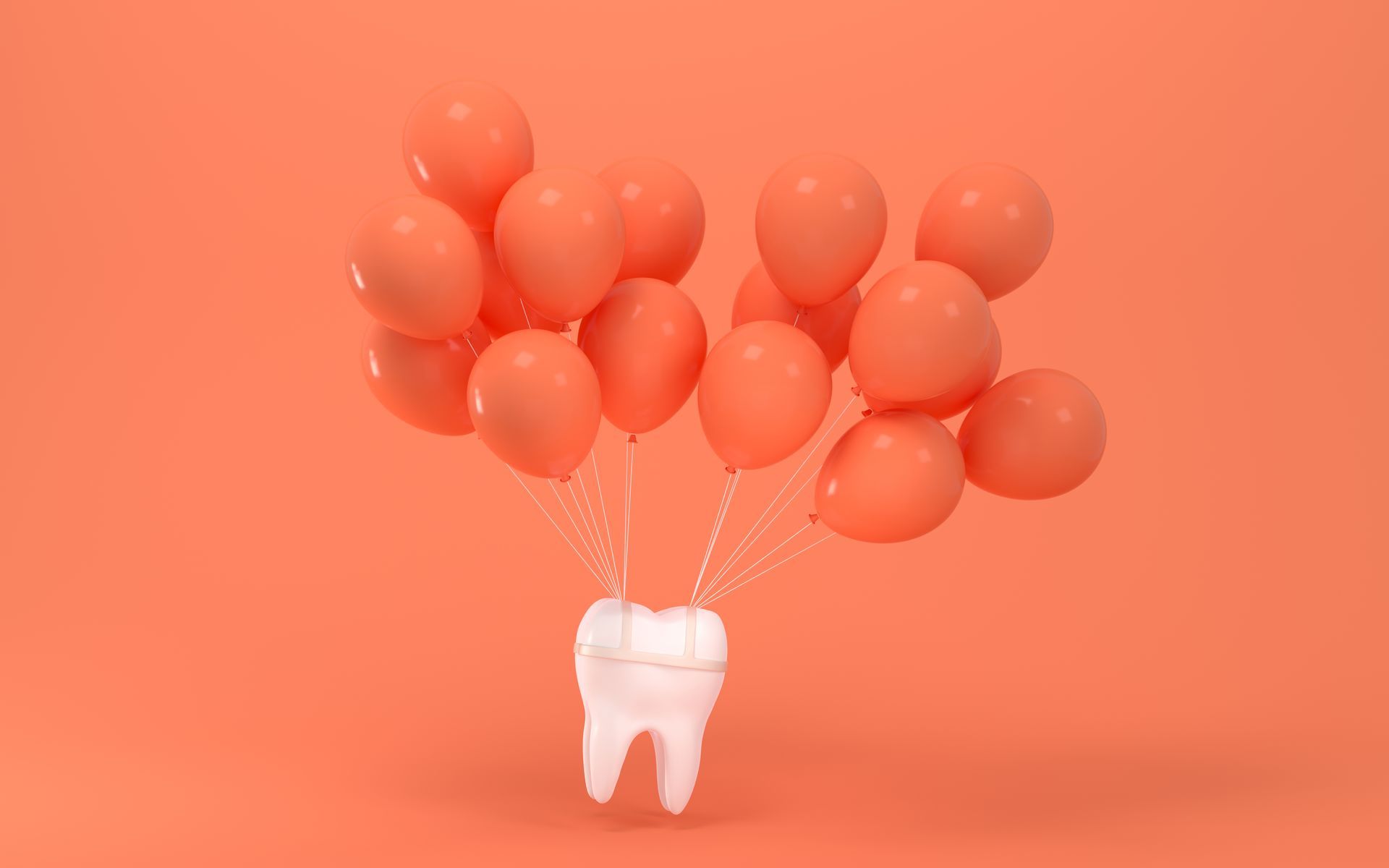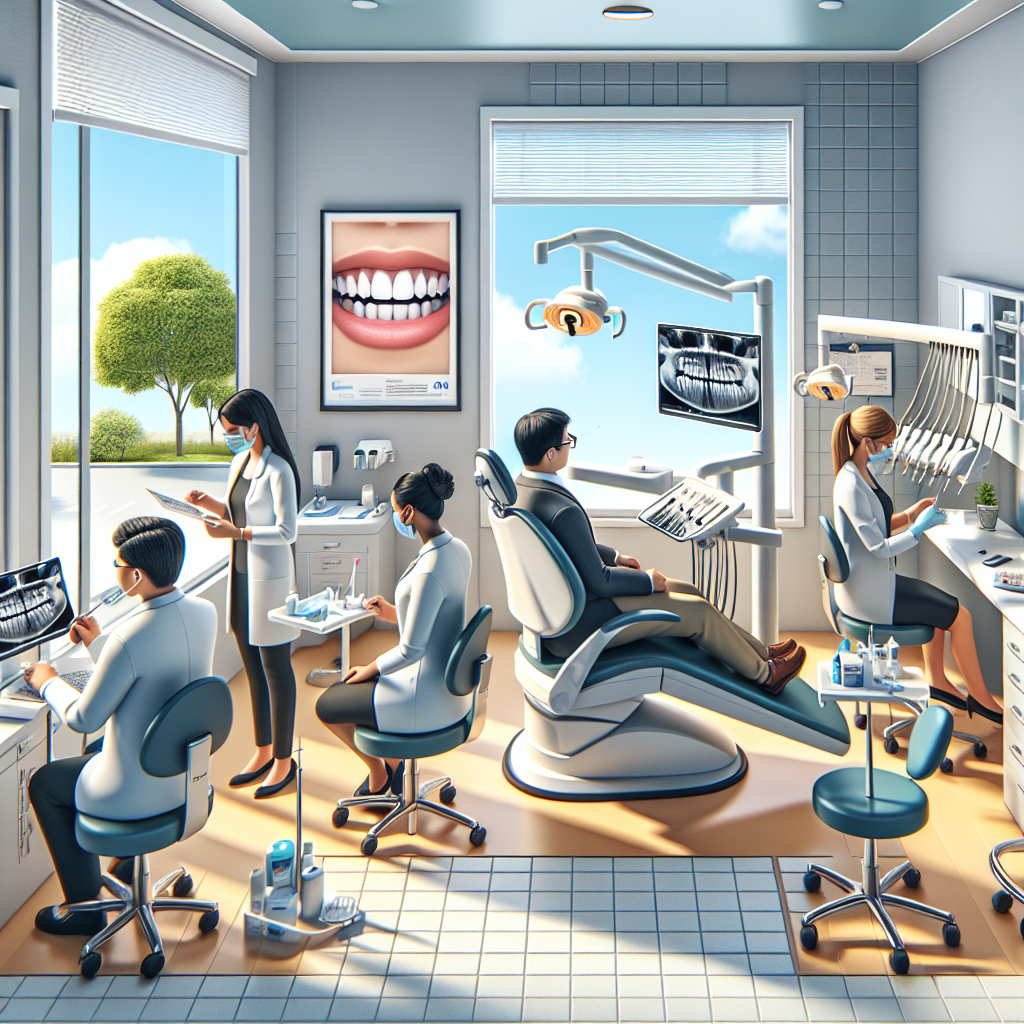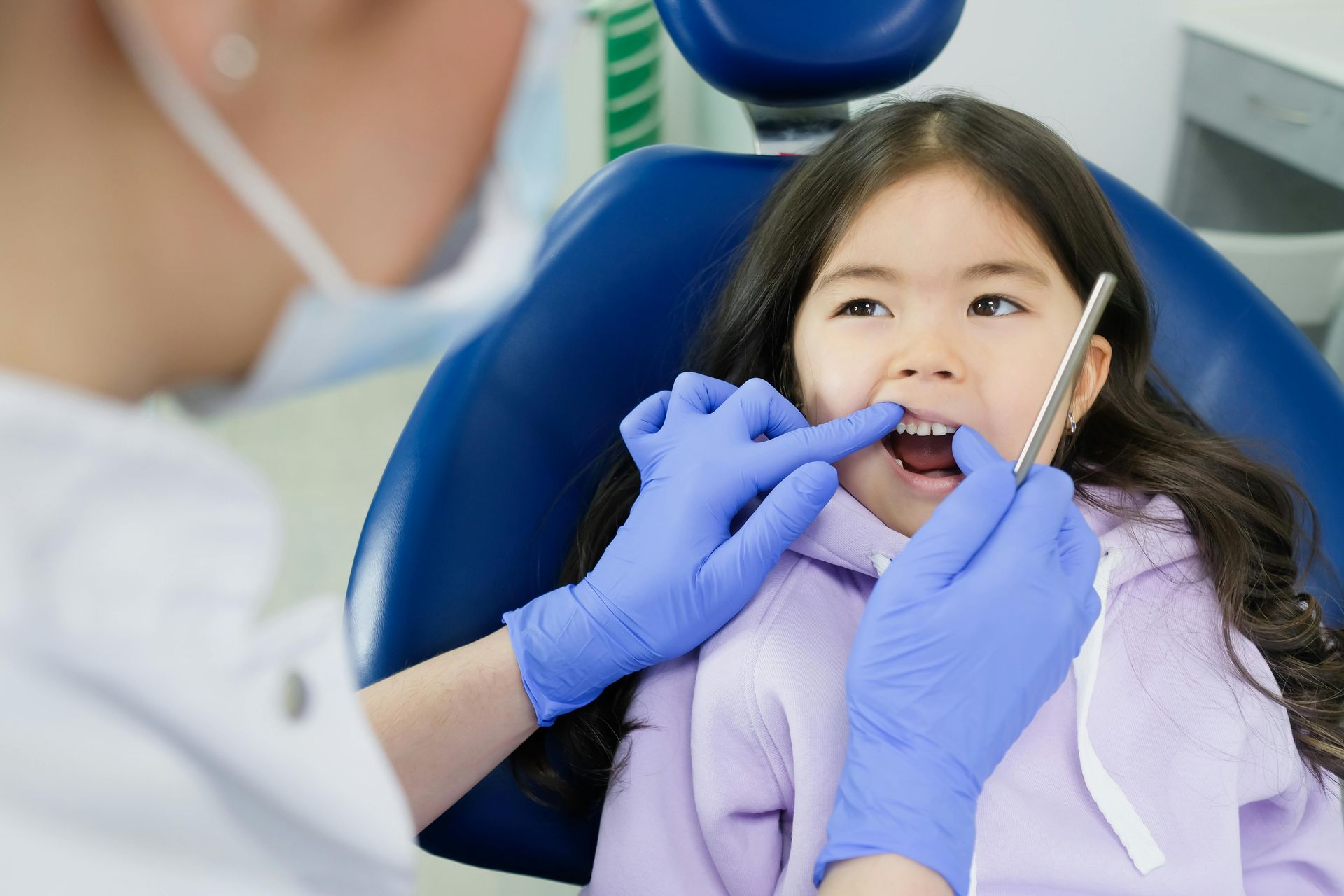
Staying on top of your oral health can often feel like a balancing act—making sure you brush and floss regularly, scheduling cleanings, and remembering those occasional check-ups. But one factor that sometimes slips under the radar is the effect of nighttime teeth grinding (bruxism) or jaw clenching. When left unaddressed, these habits can have a long-lasting impact on your smile and even contribute to disrupted sleep. Here at South Temple Dental , we believe that a custom night guard can play a pivotal role in ensuring you enjoy both peaceful rest and well-protected teeth. Understanding the Consequences of Teeth Grinding Teeth grinding, also known as bruxism, is more common than many realize. In fact, about 10% of adults and 15% of children in the United States are believed to experience bruxism . This condition can manifest itself through telltale signs such as worn-down enamel, morning headaches, jaw soreness, or even small fractures in teeth. Over time, repeated grinding can also strain the muscles in the jaw, creating tension that radiates into the neck and shoulders. If you notice you wake up with a tender jaw or suspect you are clenching during sleep, it’s wise to talk with a dental professional about whether a custom night guard is right for you. A well-fitted appliance serves as a protective shield between the upper and lower teeth, effectively minimizing the chances of serious deterioration or discomfort. How Night Guards Help Protect Your Smile When it comes to care for mild to moderate bruxism, a custom night guard is specifically molded to your teeth. Unlike over-the-counter products, these tailored guards take into account the natural alignment of your teeth and jaw. They fit securely in your mouth, making them more comfortable to wear—and a comfortable fit can also translate to better sleep quality. By ensuring your teeth do not make direct contact, a night guard can help prevent: Enamel erosion or wear. Chipping and cracking of teeth. Strain on the jaw muscles. In addition, if you have existing dental work such as crowns, veneers, or fillings, using a night guard can be an extra layer of insurance against potential damage. With protective sleep solutions like night guards, you can rest easier knowing your smile is shielded through the night. Acquiring a Custom Night Guard Getting fitted for a custom night guard is typically a simple process. First, you’ll visit your dental practice, where impressions of your teeth are taken. These impressions are then used to craft a night guard that fits seamlessly to your upper or lower teeth (or sometimes both, if that’s what your dentist deems best). After the guard is ready, you’ll have another appointment to ensure its shape and alignment feel natural in your mouth. This personalized approach typically results in an appliance that is much more efficient at preventing grinding than store-bought “one-size-fits-all” options. Moreover, your dentist can adjust its thickness or coverage if you need additional accommodations, such as for certain bite patterns or orthodontic work. Adjustment Period: What to Expect Many individuals adapt quickly to their new night guard, often finding it a surprisingly simple measure for relieving tension and preventing tooth-to-tooth contact. However, it’s not uncommon to experience mild discomfort the first few nights of wearing it—especially if you’ve never slept with a mouth guard before. Being consistent with usage tends to ease these sensations. During this period, some people also notice drooling or difficulty closing their lips entirely around their new appliance. These side effects usually subside after a short while, as your mouth becomes accustomed to the feeling. If feelings of discomfort persist or intensify over time, we encourage you to schedule a follow-up appointment. A minor readjustment can make all the difference in your overall comfort. Keeping Your Night Guard in Prime Condition A night guard is an investment in your smile, and proper maintenance goes a long way in extending its lifeline. You can typically clean the guard by gently scrubbing it with a soft toothbrush and a mild, non-abrasive cleanser—while liquid hand soap can do the trick, be sure to avoid cleansers or denture tablets containing harsh chemicals. Afterward, rinse it thoroughly with cool or lukewarm water. High temperatures may warp the material, so be sure to keep the guard away from hot water or the dishwasher. Storing your night guard correctly will also help protect it from warping and collecting bacteria. Many dentists provide a sturdy carrying case, and it’s essential to let the guard dry before placing it back in the container. For extra tips or personalized guidance, see our resources at South Temple Dental’s Night Guard Services Page and call us if you ever have concerns about the fit or condition of your guard. Boosting Overall Sleep Quality While protecting your teeth is a major benefit, the right night guard can also pair well with an overarching approach to improved sleep. Feeling relaxed, physically and mentally, is important before bed. Some helpful strategies to complement your night guard usage might include winding down with soothing music, reading briefly under soft lighting, or avoiding electronics right before sleep. Establishing a consistent bedtime routine—such as turning off devices at least 30 minutes before bed—allows your mind to enter a calm state conducive to deeper rest . Incorporating a nightly routine along with your guard can assist not only with bruxism but also with the overall quality of your sleep. Investing in Your Long-Term Oral Health A custom night guard offers more than just a comfortable night’s rest. It’s an active step toward preserving your enamel, stabilizing your jaw alignment, and minimizing the need for additional restorative procedures in the future. Waking up without jaw or tooth pain can set a positive tone for your entire day, a small but meaningful improvement in your overall quality of life. Taking the time for a custom-fitting with your dental professional can yield significant returns in the form of healthy, strong teeth—teeth that aren’t subjected to overnight grinding or clenched pressure. When cared for properly, a quality mouth guard can last for several years, making it a comprehensive, cost-effective solution for many patients. If you’re considering adding a protective appliance to your nightly routine, our team at South Temple Dental is here to help. We welcome any questions you may have about the fitting process, care regimen, and how to properly incorporate a night guard into your bedtime routine. By taking this simple but impactful step, you can safeguard your smile from the wear and tear of everyday life and rest easy all night long.

Cosmetic dentistry has made remarkable strides in recent years, offering options that were unthinkable just a few decades ago. A bright, well-aligned smile can work wonders on your self-confidence, supporting everything from personal relationships to professional interactions. In fact, research from the American Academy of Cosmetic Dentistry indicates that 99.7% of Americans believe a great smile is a significant social asset. While aesthetic improvements are at the forefront, cosmetic dental treatments focus on preserving tooth structure and enhancing overall oral health as well. Embracing Modern Cosmetic Dentistry Modern cosmetic dentistry goes beyond mere appearance. Today’s procedures address issues like discolored teeth, minor misalignments, and structural irregularities with minimal discomfort and impressive longevity. Many people turn to cosmetic dentistry when routine maintenance—such as daily brushing, flossing, and regular checkups—still leaves them longing for a more dazzling result. With advanced techniques and materials, cosmetic procedures can bridge the gap between a healthy smile and a flawless one. At South Temple Dental , we focus on delivering care that combines science, artistry, and empathy. Our approach centers on ensuring treatments align with your personal goals. Whether you want to correct a single chipped tooth or revitalize your entire smile, there’s likely a cosmetic dental solution for you. Exploring Popular Treatments While cosmetic dentistry includes a variety of procedures, some treatments have become particularly popular due to their proven effectiveness and the immediate boost in confidence they can provide. Veneers for Instant Transformation Veneers are wafer-thin shells typically made from porcelain or composite resin. They bond to the front of your teeth, offering a way to correct issues like discoloration, minor gaps, and uneven shapes. Porcelain veneers often provide a natural appearance, reflecting light similarly to tooth enamel. Dental Bonding for Subtle Enhancements Dental bonding involves applying a tooth-colored resin material to restore or improve a tooth’s appearance. This method is ideal for small imperfections, such as a chipped or slightly discolored tooth. Bonding is often completed in a single visit and can yield transformative results for patients seeking a modest adjustment. Teeth Whitening for a Bright Smile Professional teeth whitening continues to be one of the most sought-after treatments in cosmetic dentistry. The global teeth whitening market is projected to substantially grow within the next 8 years, emphasizing its widespread popularity. Professional whitening procedures are generally more effective than over-the-counter options, offering safer and more consistent results under professional supervision. Determining the Right Cosmetic Treatment No two smiles are alike, and personalizing cosmetic dentistry is crucial. Factors such as the shape of your face, your natural tooth color, and your overall dental health all influence which treatment will bring out the best in your smile. It is helpful to begin with a thorough evaluation, during which a dentist assesses any underlying issues that might affect the cosmetic treatment outcome. For example, certain gum conditions or bite problems may need to be addressed before moving forward with a purely aesthetic procedure. By addressing each patient’s unique dental requirements, cosmetic dentistry can ensure both function and beauty remain top priorities. The Role of Advancements in Your Smile Journey Thanks to advancements in materials, imaging technology, and dental techniques, many cosmetic treatments are now less invasive and more comfortable. Modern digital imaging allows dentists to plan procedures with precision, predicting outcomes before any treatment begins. This level of accuracy can help you and your dentist choose the right procedure based on sound information and an awareness of how each option will look in your unique case. Additionally, new materials and methods allow dental restorations—veneers, crowns, and bonding—to stand up better to everyday wear, often lasting for years with the right at-home care. This blend of durability and state-of-the-art diagnostics reduces the need for repeated treatments. Achieving a Confident, Radiant Smile A dazzling smile carries undeniable psychological and social benefits. Studies in the field of social psychology have repeatedly shown that individuals with enhanced smiles often feel a boost in self-esteem, which can have a ripple effect on personal and professional relationships. When you feel proud of your smile, you’re more inclined to laugh freely, speak with greater self-assurance, and enjoy situations where you can let your personality shine. Furthermore, prioritizing the health and appearance of your teeth often sparks enhanced oral hygiene habits. After investing in cosmetic procedures, people tend to be even more diligent with brushing, flossing, and attending regular dental checkups—reinforcing a cycle of better oral health and a brighter grin. Putting Your Best Smile Forward Cosmetic dentistry offers straightforward and effective ways to refine your appearance while supporting your overall well-being. With innovations in materials, techniques, and planning tools, modern dentistry equips you to choose the right treatment with confidence. By combining artistry and science, cosmetic procedures extend far beyond a superficial change—they weave together aesthetics, comfort, and dental longevity. If you’re ready to explore customized cosmetic dental procedures, we invite you to learn more about our cosmetic services at South Temple Dental . For personalized recommendations and to begin your journey toward a brilliant smile, feel free to reach out through our contact page . Our dedicated team is here to help you each step of the way, ensuring you achieve the smile you’ve always envisioned.

Restorative dentistry encompasses a variety of procedures aimed at repairing or replacing damaged teeth to improve oral function and personal confidence. Whether you are dealing with structural issues, decay, or other concerns, these treatments can make a significant difference in your daily life. By prioritizing healthy tooth function, you can look forward to speaking clearly, chewing comfortably, and maintaining a bright, inviting smile. Restorative dentistry is not just about clinical improvements, however. It also offers emotional benefits that can help you feel more self-assured. When your teeth feel strong and look healthy, you can relax in social and professional settings and focus on enjoying each moment without worrying about how your smile appears. Restorative Dentistry at a Glance Dentists who specialize in restorative treatments are dedicated to returning your teeth to their best shape and function. Treatments can address a broad spectrum of issues, from minor tooth restorations to more extensive rebuilding procedures. The goal is to preserve as much of your natural tooth structure as possible while ensuring that you can speak, eat, and smile with confidence. Many patients wonder about the difference between restorative and cosmetic dentistry. While cosmetic work often focuses on enhancing the appearance of teeth, restorative treatments address functional issues first—though an aesthetically pleasing result commonly follows. The best approach is always a combination of functionality and appearance, where your dentist helps you maintain optimal oral health while boosting your overall sense of well-being. Crowns: Protecting and Strengthening Teeth Crowns are a time-tested solution for protecting and reinforcing teeth that have undergone significant damage or decay. A crown serves as a cap that fits over a tooth to restore its shape and protect it from further wear. Discover a few ways that crowns can make a positive difference : They safeguard weakened teeth from additional damage. They restore functionality for comfortable chewing and biting. They can improve the appearance of a tooth while still blending with your natural smile. Receiving a crown often involves a precise process of shaping the damaged tooth and taking accurate measurements to ensure a perfect fit. High-quality materials, carefully matched to your existing teeth, create a seamless look that boosts your confidence every time you smile. Bridges: Addressing Missing Teeth A gap left by a missing tooth affects your smile and your ability to chew and speak normally. Missing teeth can lead to misalignment, which places extra strain on surrounding teeth and can potentially create new oral health issues. Bridges step in as an effective option for filling gaps between existing teeth. A bridge is usually anchored in place by neighboring teeth or dental implants, with the artificial tooth or teeth filling the gap. By restoring a complete row of teeth, you can reduce the likelihood of accidental biting or chewing discomfort and restore the even distribution of biting forces. This, in turn, can help you avoid stress on certain areas of your mouth, ensuring better long-term health. Restoring missing teeth with bridges can significantly boost your confidence. No longer needing to hide your smile or feeling self-conscious about gaps can lead to a renewed sense of self-assurance. You'll be able to laugh, speak, and eat without hesitation, allowing you to engage more fully in social and professional settings. This newfound confidence can positively impact your overall quality of life and how you interact with the world. Fillings: Repairing Decay and Preserving Your Smile Untreated tooth decay can worsen over time and lead to pain, sensitivity, and even infections. Fillings are one of the most common restorative treatments, serving to repair a tooth that has been damaged by decay. Not only do fillings halt the spread of decay, but they also help preserve the remaining healthy tooth structure. Modern fillings often rely on tooth-colored materials that blend seamlessly with your natural teeth. This provides a discreet option that maintains a natural look, enhancing your confidence when you speak or smile. The process generally involves removing decayed sections and thoroughly cleaning the area, ensuring long-term stability and comfort. Steps to Maintain Your Results Once your restorative treatment is complete, protect your investment. Follow these few simple guidelines: Follow Good Oral Hygiene: Brush twice a day and floss daily to keep your teeth healthy. Schedule Regular Check-Ups: Routine visits allow your dentist to monitor any changes and ensure restorations remain in good shape. Avoid Harmful Habits: Chewing on ice, pens, or hard candy can damage restorations over time. Be mindful of how you treat your teeth day to day. Maintaining these habits keeps your gums, existing teeth, and any restorative work in top condition. By taking proactive steps, you can continue enjoying the confidence a healthy, complete smile brings. The Benefits of a Renewed Smile Choosing to pursue restorative dentistry can be transformative. Not only will you regain comfort and function in your mouth, but you can also feel a surge of self-assurance with each smile you share. Dental health plays a significant role in overall wellness and can positively impact everything from your daily interactions to how you present yourself in professional settings. If you have issues with decayed, damaged, or missing teeth, consulting with a dental professional can transform both your oral health and confidence. Crowns, bridges, or fillings can make a real difference, restoring your smile and paving the way for a more fulfilling and self-assured lifestyle. At South Temple Dental, we understand the importance of a healthy, confident smile. Contact us today to learn how our restorative dentistry services can help you achieve the smile you deserve.

Salt Lake City’s unique climate and seasonal shifts influence more than just daily routines; they can also affect how you care for your teeth and gums throughout the year. From springtime allergies to winter’s cold, each season brings its own challenges. By adjusting your oral health habits to local weather patterns and common seasonal foods, you can help ensure a bright smile all year long. Adapting to Spring’s Transition in Salt Lake City Spring in Utah often begins in March, gradually ushering in warmer days while still holding onto remnants of winter chills. This transitional weather can make it easy to overlook some oral care habits. Residents who struggle with allergies might also find themselves dealing with nasal congestion and mouth breathing, which can reduce the flow of saliva and increase the risk of dry mouth issues. Focusing on staying hydrated is key, especially when dealing with changing temperatures. Regular water intake helps rinse away food particles and neutralize acids that can lead to tooth decay . Enjoying fresh fruits and vegetables—like leafy greens or strawberries—can bolster your vitamin intake and help strengthen gums. These produce options often become more widely available in the spring, so consider adding them to your daily diet for both your general and oral health. Summer Strategies for a Healthier Smile Summer in Salt Lake City is known for its dry heat, especially since Utah is one of the driest states in the country. According to the Western Regional Climate Center , the city receives only around 16.5 inches of precipitation annually. This dryness intensifies during the hot months, making it important to stay hydrated. Drinking enough water throughout the day boosts saliva production, which serves as a natural defense against bacteria and decay-causing acids. While indulging in summer treats like ice cream and sports drinks can be tempting, keep in mind that high sugar content can foster harmful bacteria in the mouth. Consider limiting sugary beverages or substituting some of your favorite sweets with mouth-friendly fruits or sugar-free options. For especially hot days, try infusing water with cucumber, mint, or citrus slices to add flavor without adding sugar. Navigating Fall with Balanced Nutrition Autumn in Salt Lake City brings cooler temperatures and an abundance of harvest foods like apples, pumpkins, and squash. These flavorful options can offer significant oral health benefits when prepared wisely. Apples, for example, have a high water content and natural fiber that support gum health by reducing plaque buildup. Pumpkins and squash provide vitamins and minerals that can help fortify teeth and gums. Along with switching up your diet to include these seasonal foods, fall is also a good time to reevaluate oral care habits after a potentially sugar-heavy summer. According to the Centers for Disease Control and Prevention (CDC) , nearly half of all adults over 30 already face some form of gum disease, and neglecting regular brushing and flossing can exacerbate this statistic. Keeping a consistent routine of brushing twice a day and flossing daily is essential to safeguard teeth from plaque buildup. Winter Tips to Keep Teeth Strong When winter arrives, the colder air and potential holiday festivities can pose challenges for maintaining optimal oral health. Although celebrations often revolve around foods like candy canes, sweets, and hearty dishes, it’s important not to focus solely on Christmas. Instead, consider moderating sugar intake across all of your winter gatherings and staying vigilant about rinsing with water after indulging in sugary treats. The colder, drier air can also affect your salivary flow, making it easier for bacteria to thrive if your mouth is not kept moist. Sipping on water throughout the day, using lip balm to prevent dryness at the corners of the mouth, and adding warm, sugar-free beverages like herbal teas to your routine can keep your oral tissues comfortable. Additionally, be mindful when enjoying hot drinks like coffee or tea, as these can stain your teeth over time if not rinsed away or brushed off regularly. Stay Connected with South Temple Dental All Year Round By aligning your oral hygiene practices with Salt Lake City’s seasonal changes, you can maintain healthier teeth and gums from one season to the next. Our team at South Temple Dental is committed to helping you achieve a year-round smile that reflects your overall well-being. We invite you to learn more about our services or to schedule a personalized consultation for tailored tips on your dental care journey. For any questions or to book an appointment, visit our contact page . We look forward to partnering with you in maintaining strong, vibrant oral health throughout every season.

Getting a tooth extracted can feel daunting, but understanding why extractions are sometimes necessary—and how to prepare for the procedure—helps alleviate anxiety. In many cases, removing a tooth can preserve and protect the overall integrity of your smile. By learning what to expect before, during, and after your appointment, you can confidently approach the process and set yourself up for a smooth recovery. Why Extractions Become Necessary Several factors can prompt a dental professional to recommend extracting a tooth. Severe decay that has compromised too much of the tooth’s structure may leave restoration efforts, such as fillings or crowns, insufficient for preserving oral health. In other situations, a tooth might be fractured or damaged beyond repair. Advanced periodontal (gum) disease affecting bone health can also lead to the need for an extraction, especially if it becomes challenging to support the stability of the affected tooth. Additionally, tooth extractions are sometimes part of comprehensive treatment plans to improve alignment or create adequate space in the mouth. If you have an impacted tooth—often a wisdom tooth that cannot fully emerge above the gum line—removal may be the best route to prevent infection and protect surrounding teeth. According to the Journal of the American Dental Association , extractions can also help manage overcrowding issues. While it’s normal to experience some worry about the process, early planning and open communication with your dental team often ease concerns and enable a confident mindset. Exploring the Procedure Modern dentistry places a significant emphasis on patient comfort, and tooth extraction procedures are typically performed under local anesthesia or another form of sedation. The first step usually involves thorough imaging—such as X-rays—to help your dentist evaluate the condition of the tooth and surrounding bone. This assessment ensures that if there are risks, such as curved or multiple roots, your dentist is well-prepared to navigate them and remove the tooth in the safest way possible. During a simple extraction, the dentist will numb the area around the tooth, and specialized tools gently loosen the tooth from its socket. If the tooth in question has not fully erupted or is severely fractured, a surgical extraction may be required. In this instance, small incisions in the gum tissue provide access to safely remove the tooth. Regardless of the method, your dental team strives to keep you comfortable throughout. You might feel pressure during the procedure, but pain sensations should be minimal. If you experience discomfort, it’s important to communicate immediately with your dental professional so they can adjust your level of anesthesia or sedation. Helpful Tips for a Stress-Free Experience Because dental visits can stir up apprehension in some patients, taking a few simple steps beforehand makes a difference in how you feel. Plan to discuss any existing medical conditions, allergies, or medications with your dentist in advance. This helps your dental team tailor the treatment plan to your specific needs and ensure optimal safety. Avoid eating a large meal directly before an extraction if you’ll be sedated, but do follow any instructions your dentist provides regarding water intake or light snacking. Preparation extends beyond the logistical details. For instance, calming exercises—like diaphragmatic breathing or gentle stretching—can help relax your mind while you wait. If you have concerns about the procedure itself, talking openly with your dentist or hygienist often relieves worries. They can walk you through exactly what to expect, address any fears, and discuss customization options like sedation. Remember that choosing a trusted dental practice that prioritizes clear communication is a vital step toward a worry-free experience. Post-Extraction Care for a Successful Recovery The recovery phase plays a critical role in ensuring that your mouth heals swiftly and thoroughly. Immediately after an extraction, it is common to apply gauze to the site, helping to control bleeding and create a blood clot. Be mindful not to disturb the clot, as it protects the underlying bone and nerve endings. Avoid rinsing your mouth vigorously, drinking through a straw, or consuming overly hot foods for at least the first 24 hours. Doing so might dislodge the clot and prolong healing. As your mouth recovers, stick to soft foods that require minimal chewing—soups, yogurt, applesauce, and mashed vegetables are typically easy to manage. Make sure to drink plenty of fluids but limit alcoholic or caffeinated beverages, as they can slow the healing process. Good oral hygiene is still essential, but be gentle around the extraction site. Carefully brushing off plaque in other areas of the mouth and rinsing lightly with a mild saline solution—recommended by many dentists and backed by Mayo Clinic —can keep the healing site clean without creating irritation. If you notice persistent swelling, prolonged bleeding, or discomfort that worsens over time, contact your dentist promptly. Planning Your Follow-Up Visit After an extraction, follow-up visits help gauge the progress of your recovery. Your dentist may recommend an appointment around a week or two later to make sure the socket is healing well and to check for any complications. This visit is also an excellent time to discuss a long-term plan for replacing the extracted tooth if needed. Options like dental implants, bridges, or partial dentures are popular methods to address gaps, enhance aesthetics, and maintain proper chewing function. By consulting with your dental professional, you’ll gain personalized insights into whether a temporary restorative solution or a permanent replacement is best suited for you. Investing in a timely replacement not only preserves your smile’s appearance but also supports the integrity of your remaining teeth. Missing teeth can shift over time, and your jawbone health may be affected if they are not replaced. Addressing these concerns early ensures a strong foundation for your continued oral wellness. Where to Learn More and Take the Next Step Recovering from a tooth extraction can be more straightforward than you might imagine when you are equipped with the right information and a caring dental team. Having a clear plan, understanding the procedure, and knowing how to care for yourself afterward make all the difference in feeling confident about your oral health journey. If you have questions about the tooth extraction process or want personalized guidance, visit the Contact Us page on our website. We’re here to help you schedule an appointment, address any concerns, and guide you toward additional services that promote a healthy, beautiful smile. At South Temple Dental, you’ll find a friendly team ready to support you at every phase of your dental care. Let us partner with you to ensure that your tooth extraction experience is as comfortable, efficient, and positive as possible.

Dental sealants offer a proactive way to protect young teeth from cavities, helping children maintain happier, healthier smiles. By forming a strong shield against harmful bacteria, sealants can significantly reduce the risk of tooth decay over the long haul. Below, we delve into how this preventive measure works, the recommended age for receiving them, and the common myths that sometimes surround dental sealants. Understanding the Power of Dental Sealants The concept behind dental sealants is simple yet powerful: a thin, protective coating is placed on the chewing surfaces of back teeth (molars and premolars) to keep food debris and bacteria from settling into the grooves. According to the Centers for Disease Control and Prevention (CDC) , dental sealants have the potential to prevent up to 80% of cavities in the back teeth—the most common area children develop cavities. While brushing twice a day and flossing daily remain crucial, sealants serve as a valuable extra line of defense. Even the most thorough at-home cleaning can miss tiny crevices that house bacteria. Elastic sealants fill those small nooks, preventing decay at its earliest stages. How Sealants Protect Growing Smiles When a child gets a sealant, the tooth surface is first cleaned and dried. Afterward, a solution is gently applied to the tooth to help the sealant bond better. The final step is painting the sealant onto the enamel, where it hardens within seconds under a special curing light. Because the sealant is almost invisible, children can enjoy capped protection without any impact on speech, chewing, or appearance. Once applied, sealants form a reliable barrier that can last for several years, though regular dental checkups will confirm if sealants need reapplication. The American Dental Association (ADA) endorses the use of sealants as an effective form of cavity prevention, as noted in their sealant guidelines . By supplementing routine brushing and flossing, this added shield can provide an extra layer of security for developing smiles. Ideal Age for Dental Sealants Children begin to get their permanent molars around age six, with additional molars appearing in their early teens. During these formative years, introducing dental sealants is often recommended. By coating the back teeth soon after they come in, the risk of cavities can be greatly minimized. While the ideal window for applying sealants is generally around the age children receive their permanent molars, it is never too late to consider this treatment if your child is prone to cavities or has deeply grooved teeth. Talking with a trusted pediatric or general dentist about your child’s dental health history can help determine the right time to apply sealants. Common Myths, Clarified Even with a solid record of success, questions sometimes arise about dental sealants. Let’s address a few: “Sealants contain harmful substances.” Modern sealants are designed to be safe and effective. Many are BPA-free, and any concerns about chemical exposure should be discussed directly with your dentist, who can verify specific product information. “Fluoride does the same job as sealants.” Although fluoride (in toothpaste, mouthwash, and tap water) strengthens enamel and helps resist decay, sealants specifically protect the areas that are most vulnerable to bacteria and plaque. Both fluoride and sealants work together within a comprehensive cavity-prevention strategy. “Sealants make it harder to clean teeth.” In reality, sealants can make brushing more effective by smoothing over the deep grooves that often trap food. Dental hygiene routines continue as normal, and your child’s dentist will still check on the integrity of the sealants at regular visits. Moving Forward Toward Healthier Smiles One of the most rewarding aspects of dental sealants is the boost it gives to both parents and kids. Parents breathe easier knowing they’ve proactively reinforced their child’s teeth, and children feel more enthusiastic about their dental visits when they know they have an extra layer of protection against cavities. In addition to these benefits, maintaining a consistent oral hygiene routine at home remains essential. By combining the protective power of sealants with proper brushing, flossing, and regular dental checkups, you’ll encourage a lifetime of strong and healthy teeth. As your child grows, their dentist can keep an eye on how well the sealants are holding up, ensuring a truly long-lasting defense. Next Steps for a Brighter Smile If you’d like to learn more about how dental sealants could fit into your child’s preventive care plan, we invite you to explore our comprehensive services at South Temple Dental . Whether you’re new to our practice or someone we see regularly, we’re here to make every dental visit as comfortable and beneficial as possible. To schedule a consultation or ask any further questions, please visit our Contact page . We look forward to helping your family take the next step in safeguarding those growing smiles.

Dental emergencies can be sudden and distressing, often requiring swift action to prevent further damage or alleviate pain. These situations differ from regular dental issues that can be scheduled for later appointments, as emergencies demand immediate attention. Whether it's a severe toothache or a chipped tooth from an accident, knowing how to handle such emergencies is crucial for maintaining oral health and avoiding complications. Understanding Dental Emergencies Dental emergencies encompass a variety of urgent oral health issues. These include chipped or broken teeth, severe toothaches, and lost fillings, each with its own set of challenges. Chipped teeth might result from accidents or biting down on something hard, leading to sharp edges that can cut the tongue or gums. Severe toothaches often signal deeper issues such as infections or decay, which require prompt intervention to prevent worsening. Lost fillings expose sensitive areas of the tooth, causing pain and increasing the risk of further damage. According to the American Dental Association, dental emergencies are a common reason for emergency room visits in the United States. Immediate Steps to Take in a Dental Emergency In the event of a dental emergency, staying calm is essential. Quick, thoughtful actions can make a significant difference. For a chipped tooth, rinse your mouth with warm water and save any fragments. If you're experiencing a severe toothache, gently floss to remove any trapped food and rinse with warm salt water to help reduce swelling. Temporary measures like covering sharp edges with dental wax can provide relief until you reach a dentist. Over-the-counter pain relievers can help manage discomfort, but placing aspirin directly on the gums is not advised as it may cause burns. The key is to seek professional dental care promptly to address the root of the problem and prevent further complications. When to Seek Professional Help Certain symptoms necessitate immediate professional attention. Persistent pain, swelling, or bleeding that doesn't subside with initial home care indicates the need for urgent dental intervention. Ignoring these signs can lead to infections, abscesses, or permanent damage to teeth and gums. For residents of Salt Lake City, UT, contacting a local dental professional quickly is crucial. South Temple Dental offers emergency services to address these urgent needs, ensuring timely care. Recognizing when to seek professional help can prevent minor issues from escalating into severe dental problems. Temporary Solutions and Home Remedies While awaiting professional care, several safe home remedies can help manage pain and discomfort. Clove oil, known for its analgesic properties, can be applied to the affected area using a cotton ball. A saltwater rinse can reduce swelling and cleanse the area, providing temporary relief. Caution is necessary to avoid unproven or harmful methods. For example, using superglue to reattach a lost filling is not advisable. It's always best to consult with a dentist before trying any new home remedy to ensure safety and effectiveness. Preparing for Dental Emergencies Preparation is vital for effectively handling dental emergencies. Assembling a basic dental emergency kit can be incredibly useful. This kit should include items like dental floss, pain relievers, dental wax, and temporary filling material. Regular dental check-ups are also important, as they can help prevent emergencies by identifying and addressing potential issues early. Educating family members, especially children, on how to respond during a dental emergency is beneficial. Teaching them to remain calm and follow basic first-aid steps can make a significant difference in managing the situation effectively. Local Resources and Support in Salt Lake City, UT Residents of Salt Lake City have access to various local resources for dental emergencies. South Temple Dental, located centrally, provides comprehensive emergency dental care. The community also benefits from several initiatives aimed at supporting dental health and emergency care in the area. Being familiar with local resources ensures you know where to turn in a dental emergency. The Utah Department of Health offers a directory of local health services, including dental clinics and emergency services, which can be invaluable in urgent situations. The Role of Regular Dental Check-Ups Regular dental check-ups play a critical role in preventing dental emergencies. By identifying potential problems early, such as cavities or gum disease, these routine visits can address issues before they escalate into emergencies. Dentists can also provide valuable advice on maintaining oral health and preventing common dental problems. Educating Children About Dental Emergencies Teaching children about dental emergencies is an important step in ensuring they know how to react when faced with such situations. Simple instructions on what to do if they chip a tooth or experience a toothache can empower them to handle emergencies calmly. Encouraging them to communicate any oral discomfort promptly can lead to early intervention and prevent more serious issues. Building a Relationship with Your Dentist Establishing a good relationship with your dentist can make a significant difference during emergencies. A dentist familiar with your dental history can provide more personalized care, which is particularly beneficial when urgent issues arise. Regular visits help build this relationship, ensuring you have a trusted professional to turn to in times of need. Exploring Advanced Dental Treatments Advancements in dental technology have made it possible to address emergencies more effectively. Treatments like digital X-rays, laser therapy, and minimally invasive procedures can provide quicker and more accurate diagnoses, leading to better outcomes. Staying informed about these advancements can help you make educated decisions during dental emergencies. Importance of Oral Hygiene Maintaining good oral hygiene is crucial in preventing dental emergencies. Regular brushing and flossing can reduce the risk of cavities and gum disease, common precursors to emergencies. Incorporating mouthwash into your routine can also help eliminate bacteria that may lead to infections. The Psychological Impact of Dental Emergencies Dental emergencies can be stressful, affecting both physical and mental well-being. Understanding the psychological impact and seeking support when needed can help manage anxiety associated with dental issues. Relaxation techniques and open communication with your dentist can alleviate stress during treatment. Understanding and managing dental emergencies are essential for maintaining oral health and preventing complications. By taking immediate action, knowing when to seek professional help, and preparing in advance, you can effectively handle any dental emergency that arises. Regular check-ups, good oral hygiene, and being informed about local resources all contribute to better preparedness and outcomes in urgent situations. Our team is committed to offering prompt, professional service to address urgent dental needs. Reach out to South Temple Dental today for compassionate and comprehensive dental care when you need it most.

Maintaining oral health is a crucial component of overall wellness. While daily brushing and flossing are fundamental practices, they are just the beginning of a more extensive approach to dental care. Regular dental check-ups and a variety of dental services play a significant role in preserving oral health, which in turn contributes to overall well-being. Exploring the various aspects of comprehensive dental care reveals how preventive measures, such as professional cleanings and early detection of oral issues, can avert more serious health problems down the line. Adopting a balanced diet and avoiding harmful habits like smoking further enhance dental health, supporting the body's overall resilience. The Connection Between Oral Health and Systemic Health Oral health is deeply connected to systemic health . Poor oral hygiene can be linked to serious health conditions like heart disease and diabetes. The mouth acts as a gateway to the body, making its health essential in preventing complications that can arise from bacteria and infections. Understanding this connection emphasizes the importance of maintaining oral hygiene as a preventive measure against broader health issues. Regular visits to the dentist not only help in diagnosing and managing oral diseases but also serve as an early warning system for potential systemic health problems. Educating patients about the impact of oral health on their overall health can lead to more proactive and informed healthcare decisions. Regular Check-Ups: The Foundation of Oral Health A dental check-up is more than a glance at your teeth. It involves professional cleaning to remove plaque and tartar, examination for cavities, and oral cancer screening. These elements are crucial for maintaining oral health and identifying potential issues early on. Early detection and prevention of dental issues can save patients from more serious health problems and costly treatments in the future. Regular visits to the dentist ensure that any developing issues are addressed promptly, preventing them from escalating into more significant concerns. Having a consistent dental care provider, like those at South Temple Dental in Salt Lake City, UT, allows for a deeper understanding of your dental history and personal needs, further enhancing the quality of care you receive. Services Beyond the Routine: What to Expect from Your Dentist Dentists offer a broad spectrum of services beyond routine check-ups. Periodontal care is vital for maintaining gum health, while fillings and root canals address decay and infection, preventing them from spreading further. These treatments are essential for preserving the structural integrity of your teeth and preventing pain and discomfort. Cosmetic dentistry, though often viewed as primarily aesthetic, plays a crucial role in boosting self-esteem and mental well-being. A healthy, confident smile can significantly impact how individuals perceive themselves and interact with others, enhancing social interactions and professional relationships. Advancements in dental technology, such as laser dentistry, have greatly improved patient comfort and treatment outcomes. These innovations allow for more precise and less invasive procedures, reducing recovery times and enhancing the overall dental experience. Pediatric Dentistry: Building Healthy Habits Early Starting dental care early in life is critical for establishing lifelong healthy habits. Pediatric dentistry focuses on preventive care and education for both children and parents. By teaching children proper brushing and flossing techniques, dentists help lay the groundwork for a lifetime of good oral hygiene. Positive dental experiences in childhood can have a lasting impact, shaping how individuals approach dental care throughout their lives. A welcoming and supportive environment, such as that provided by South Temple Dental in downtown Salt Lake City, UT, helps ensure that children feel comfortable and confident during their visits. The Role of Nutrition in Oral Health Nutrition plays a significant role in oral health. A diet rich in vitamins and minerals supports healthy teeth and gums, while excessive sugar and acidic foods can contribute to tooth decay and erosion. Educating patients about the impact of their dietary choices is an essential part of comprehensive dental care. Dentists can provide guidance on nutrition to help patients make informed choices that support their oral health. The Importance of Oral Hygiene Education Education is a cornerstone of effective dental care. Understanding the proper techniques for brushing and flossing, as well as the importance of regular dental visits, empowers patients to take control of their oral health. Dental professionals at South Temple Dental prioritize patient education, ensuring that individuals have the knowledge they need to maintain their oral hygiene between visits. Stress and Oral Health: An Overlooked Connection Stress can have a profound impact on oral health. Conditions such as bruxism (teeth grinding) and temporomandibular joint disorder (TMJ) are often exacerbated by stress. Recognizing the signs of stress-related dental issues and addressing them promptly can prevent long-term damage to the teeth and jaw. Dentists can provide solutions such as night guards or stress management techniques to help alleviate these problems. The Impact of Smoking on Oral Health Smoking is detrimental to oral health , contributing to conditions such as gum disease, tooth decay, and oral cancer. Quitting smoking is one of the most effective ways to improve oral health and reduce the risk of serious complications. Dental professionals can offer support and resources to help patients quit smoking and improve their overall health. The Future of Dental Care: Innovations on the Horizon The field of dentistry is continually evolving, with new technologies and techniques emerging to improve patient care. Innovations such as 3D printing, teledentistry, and regenerative dentistry are set to revolutionize the way dental care is delivered. Staying informed about these advancements allows patients to take advantage of the latest treatments and technologies for optimal oral health. Comprehensive dental care is essential for maintaining not only oral health but also overall well-being. Regular check-ups, a wide range of dental services, and a focus on early education all contribute to a healthier, happier life. South Temple Dental in Salt Lake City, UT, exemplifies the commitment to providing high-quality, personalized care that meets the unique needs of each patient. By prioritizing oral health, individuals can enjoy improved overall health and a higher quality of life. For personalized dental care that meets your unique needs, contact South Temple Dental today . Our dedicated team is committed to providing high-quality services and ensuring the health and well-being of our patients.

Pediatric dentistry plays a significant role in laying the foundation for lifelong dental health. By focusing on the dental needs of children from an early age, pediatric dentists help detect and prevent potential dental issues before they become serious. Early dental care is crucial in identifying problems such as cavities and misalignment, which, if left untreated, can lead to more severe complications later in life. Pediatric dentists also educate both parents and children about proper oral hygiene habits, which are essential for maintaining healthy teeth and gums as children grow. Early dental visits are a preventative measure that should not be overlooked. It is recommended that a child's first dental visit be scheduled by their first birthday. Early visits allow dentists to identify potential problems, such as misalignment or cavities, at an early stage. Regular check-ups are vital in maintaining oral health and preventing future dental problems. Creating a positive dental experience during these early visits is crucial in reducing anxiety and fear in children, ensuring that they view dental care as a normal and non-threatening part of their routine. Early Dental Visits: A Preventative Measure Scheduling a child's first dental visit by their first birthday is an important step in preventive dental care. Early visits help identify potential problems such as misalignment or cavities before they become more serious. Regular check-ups play a crucial role in maintaining oral health and preventing future dental issues. By fostering a positive dental experience, pediatric dentists help reduce anxiety and fear in children, encouraging a lifelong positive attitude towards dental care. What to Expect During a Pediatric Dental Appointment A typical pediatric dental appointment includes several procedures and evaluations aimed at ensuring the child's oral health. These appointments often involve teeth cleaning, fluoride treatments, and X-rays. Pediatric dental offices are designed to be child-friendly, ensuring comfort and ease for young patients. This approach helps children feel at ease and makes the experience more enjoyable for them. Educating Parents and Children on Oral Hygiene Pediatric dentists play a vital role in educating parents and children about effective oral hygiene practices. Parents can encourage children to brush and floss regularly by setting a good example and making oral hygiene a fun and engaging activity. A healthy diet is also essential in maintaining healthy teeth and gums. Limiting sugary snacks and drinks can significantly reduce the risk of cavities and other dental issues. By making oral hygiene an enjoyable part of their daily routine, parents can help their children develop lifelong healthy habits. Common Dental Issues in Children and How to Address Them Children often face common dental issues such as cavities, gum disease, and tooth decay. Pediatric dentistry addresses these problems through preventive and restorative measures. Early intervention is crucial in preventing more serious dental problems later in life. Parents can monitor their children's oral health by watching for signs of dental issues and maintaining regular dental visits. By addressing these issues early, parents can help ensure their children's long-term dental health. The Impact of Cultural and Geographical Factors on Pediatric Dentistry Cultural beliefs and practices can significantly influence attitudes towards pediatric dental care. In Salt Lake City, UT, there are specific challenges and considerations in providing pediatric dental care. Local initiatives and programs aim to improve pediatric dental health in the area, addressing these challenges and promoting better oral health for children. Understanding these cultural and geographical factors is essential in providing effective pediatric dental care. The Future of Pediatric Dentistry Emerging trends and technologies are shaping the future of pediatric dentistry. Innovations such as laser dentistry and digital imaging are improving the quality and accessibility of dental care for children. These advancements make procedures less invasive and more comfortable for young patients. Staying informed about new techniques and practices is essential for ensuring the best possible care for children. As technology continues to evolve, pediatric dentistry will continue to improve, offering even better outcomes for young patients. Encouraging a Positive Dental Experience for Children Parents can help their children develop a positive attitude towards dental visits by preparing them for what to expect and addressing any fears or anxieties. Pediatric dentists play a crucial role in creating a welcoming and supportive environment for young patients. Building trust between the dentist, the child, and the parents is essential in ensuring a positive experience. Dental practices often use successful approaches, such as using child-friendly language and creating a fun atmosphere, to ensure that children have a positive experience during their visits. Pediatric dentistry is a vital component of lifelong dental health. By focusing on preventive care, education, and creating positive experiences, pediatric dentists help children develop healthy habits that will benefit them throughout their lives. As the field of pediatric dentistry continues to evolve, it will offer even more opportunities to improve the oral health of children in Salt Lake City and beyond.
